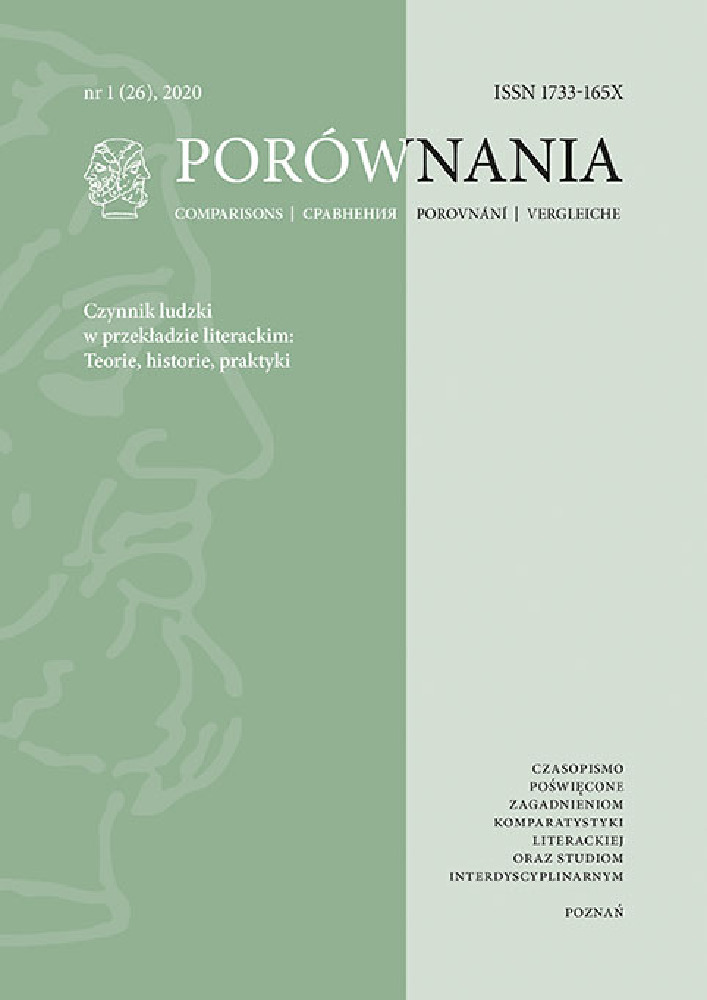Abstract
The inspiration for the paper was the metaphor that Dougles Hofstadter applies to translation. He defines the task of the translator – with particular reference to translation of literary texts – as that of the builder of a bridge that spans the canyon, joining its two sides: the original and the translation. An initial rickety foot-bridge, it gradually turns into a sturdy construction with the translator’s repeated attempts at discovering ever-deepening layers of meaning. Inevitably subjective, the building process requires the translator’s concentration upon individual dimensions of the translated text. These dimensions, or aspects, come strikingly close to what is defined as dimensions of imagery in Ronald Langacker’s model of grammar and natural language. In a wider perspective, the convergence is an argument for transdisciplinarity as a valid approach to translation studies. The translator is led by his own competence, imagination and the feeling of empathy, but at the same time they are constrained by “a short leash”: restrictions imposed by languages, cultures and the peculiarities of individual context. To illustrate the point, the author discusses a text (taken from her own translator’s dossier) in which multiple, and sometimes conflicting, identities of the protagonist require particular attention to lexical and stylistic minutiae. It is such details that constitute the leash, at the same time enabling the translator to construct the bridge.
References
Ackroyd, Peter. Three brothers. Londyn: Chatto & Windus, 2003.
Balcerzan, Edward. Literackość. Modele, gradacje, eksperymenty. Toruń: Wydawnictwo Naukowe Uniwersytetu Mikołaja Kopernika, 2013.
Brożek, Bartosz. Granice interpretacji. Kraków: Copernicus Center Press, 2014.
Cieślikowska, Dominika. „Tożsamość społeczna”. Edukacja antydyskryminacyjna. Podręcznik trenerski. Red. M. Branka, D. Cieślikowska. Kraków: Stowarzyszenie Willa Decjusza, 2010. S. 66-74.
Gentner Deidre, Holyoak Keith J., Kokinov Boris, red. The Analogical Mind. Perspectives from Cognitive Science. Cambridge, Mass.: the MIT Press, 2001.
Hermans, Theo. Narada języków. Przeł. zespół. Kraków: Wydawnictwo UJ, 2005.
Hofstadter, Douglas R. Le Ton beau de Marot. In Praise of the Music of Language. Nowy Jork: Basic Books, 1997.
Hofstadter, Douglas R. “Analogy as the core of cognition”. The Analogical Mind.
Perspectives from Cognitive Science. red. D. Gentner, K. J. Holyoak, B. Kokinov. Cambridge, Mass.: the MIT Press, 2001. S. 116-144.
Hofstadter Douglas R. Sander Emmanuel. Surfaces and Essences: Analogy as the Fuel and Fire of Thinking, New-York: Basic Books, 2013.
Itkonen, Esa. “Iconicity, analogy, and universal grammar”. Journal of Pragmatics 22 (1994). S. 37-53.
Kociuba, Jolanta. „Kulturowe tło dysfunkcji tożsamości jednostki”. Kultura i Wartości 18 (2016). S. 15-35.
Langacker, Ronald W. Gramatyka kognitywna. Wprowadzenie. Przeł. zespół. Kraków: Universitas, 2009a.
Langacker, Ronald W. Investigations in Cognitive Grammar. Berlin: Mouton de Gryuter, 2009b.
„Literatura Holokaustu”. Web. 01.11.2019. <https://tinyurl.com/yceommx2>Monneret, Philippe. “Iconicity as a Function of Analogy”. Book of abstracts.
The 12th International Symposium on Iconicity in Language and Literature | 3-5 May 2019. S. 94-95.
Paleczny, Tadeusz. Socjologia tożsamości. Kraków: Oficyna Wydawnicza AFM, 2008.
Powell, Irena. The Daughter Who Sold Her Mother. A Biographical Memoir Bloomington: authorHouse, 2016.
Powell, Irena. Córka, która sprzedała matkę. Wspomnienia rodzinne. Przeł. Elżbieta Tabakowska. Kraków: Austeria, 2020.
Skrzypecki, Maciej. Praktyka translatorska Stanisława Barańczaka w świetle teorii analogii Douglasa R. Hofstadtera. Niepublikowana rozprawa doktorska. 2018. Web. 19.05.2020. <https://tinyurl.com/yc739jom>
Słownik angielsko-polski. Web. 01.05.2020. <https://tinyurl.com/y9ma4v6e>
Tabakowska, Elżbieta. „Empatia – w języku, w tekście, w przekładzie”. Kognitywistyka 3. Empatia, obrazowanie i kontekst jako kategorie kognitywistyczne.Red. H. Kardela, Z. Muszyński, M. Rajewski. Lublin: Wydawnictwo UMCS,2012. S. 153-166.
Tabakowska, Elżbieta. Językoznawstwo zastosowane. Kraków: Austeria, 2019.
Wysocka, Ewa. „«My» i «oni» – dlaczego tak trudno być razem? Odpowiedź pedagoga, psychologa i socjologa”. Migracja, uchodźstwo, wielokulturowość.
Zderzenie kultur we wpółczesnym świecie. Red. D. Lalak. Warszawa: Wyd. Akademickie ŻAK, 2007. S. 13-63.
License
Utwory opublikowane w czasopiśmie „Porównania”, na platformie Pressto należącej do Uniwersytetu im. Adama Mickiewicza w Poznaniu są udostępniane na licencji Creative Commons Uznanie autorstwa - Bez utworów zależnych 4.0 Międzynarodowe (CC BY-ND 4.0)
Tym samym wszyscy zainteresowani są uprawnieni do korzystania z utworów opublikowanych pod następującymi warunkami:
-
uznania autorstwa — czyli obowiązek podania wraz z rozpowszechnianym utworem informacji o autorstwie, tytule, źródle (odnośniki do oryginalnego utworu, doi) oraz samej licencji
-
bez utworów zależnych — remiksując, przetwarzając lub tworząc na podstawie utworu, nie wolno rozpowszechniać zmodyfikowanych treści.
-
brak dodatkowych ograniczeń — nie można korzystać ze środków prawnych lub technologicznych, które ograniczają innych w korzystaniu z utworu na warunkach określonych w licencji.
Uniwersytet im. Adama Mickiewicza w Poznaniu zachowuje prawo do czasopisma jako całości (układ, forma graficzna, tytuł, projekt okładki, logo itp.).
Autor zachowuje prawa majątkowe, ale udziela zgody Uniwersytetowi im. Adama Mickiewicza w Poznaniu na wykorzystanie dzieła. Autorzy tekstów zakwalifikowanych do publikacji proszeni są o wypełnienie podpisanie i przesłanie umowa (PL) agreement (EN)
Agreement for granting a royalty-free license to works with a commitment to grant a CC sub-license




